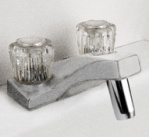Assistive Technology for Behavioral Safety and Self-Protection
Individuals with cognitive and/or behavioral disabilities often need help preventing behaviors which challenge their safety living at home. If you are caring for someone with this type of disability--such as a child with autism or an adult with Alzheimer's--this page was created to let you know about the growing range of assistive technology (AT) products that exists to help you.
Keep in mind that some AT solutions are sophisticated, like GPS tracking systems, but many are simple and inexpensive, like door knob guards or refrigerator latches. Certainly not every solution can work for every individual or situation, but common problems such as kitchen safety, getting up unassisted and wandering are addressed by a variety of options. Sometimes a simple device can make a big difference toward keeping a loved-one living at home.
Note: links to external web sites open in a new window. Links for device types (i.e. an electric plug lock) may be to a listing at a private catalog or to a publicly-funded AT database. Please explore these resources to learn the full range of what is available to you.
- Bathroom Safety
- Bed Safety
- Car Safety
- Chair and Wheelchair Safety
- Doors and Exits
- Electrical Safety
- Kitchen Safety
- Self-Protection
- Telephone Access
- Wandering/Tracking
- Further Resources
Reminder: MassMATCH and the U.S. Department of Education make no endorsement, representation, or warranty expressed or implied for any product, device, or information set forth on this website. Neither MassMATCH nor the U.S. Department of Education has examined, reviewed, or tested any product or device contained on the MassMATCH website.
Bathroom Safety
- Bathroom flood alarms
- Bathtub alarm
- Electric plug lock (to prevent appliance use)
- Anti-scalding device
 Easy-to-install, screw-on, anti-scalding devices turn off the water if the water gets too hot.
Easy-to-install, screw-on, anti-scalding devices turn off the water if the water gets too hot.
Bed Safety
- Specialty beds
- Bed rails
- Bed pads with wireless remote alarms
When this pad is stepped on, the portable wireless alarm is sounded.
Car Safety
When the two pieces of the seat belt are not engaged, the device emits a moderately loud alarm.
Chair and Wheelchair Safety
- Seat belts and seat belt alarms
- Anti-rollback and anti-tipping devices
- Specialty chairs
- Fall prevention alarm
This alarm attaches to the back of the chair and then clips to the user’s clothing with a cord and a pin.
Doors and Exits
- Door and window alarms
- Door stop alarms
- Confounding door locks
- Gate locks
- Door stop signs
- Door murals (to conceal)
- Door guards
Door sensor with wireless portable alarm
Electrical Safety
- Outlet cover with alarm
- Electrical plug lock (prevents appliance use)
Plug any appliance into this keyed lock and it becomes unusable.
Kitchen Safety
- Stove top fire fighter
- Motion detector stove monitor
- Invisible cabinet locks
- Refrigerator latches
- Anti-scalding devices
- Electric plug lock (to prevent appliance use)
- Automatic stove shut off (electric)
The HomeSenser is there to remind us about the cooking we have left unattended and to shut off the stove if we don't return.
Self-Protection
Protects the wearer from cigarette burns and accidents
Telephone Access
Dial-less telephone allows users to receive but not make calls.
Wandering/Tracking
- Stray away alarms
- Personal tracking devices and systems
- Motion detectors
- Voice ID tags
- Temporary tattoos with a purpose
- Medical medallions
- Wandering Patient Systems (an AbleData umbrella term)
EmFinder’s tracking bracelet ties to the national E-9-1-1 emergency system, helping pinpoint the location of a missing person in virtually any environment.
Further Resources
MassMATCH AT Regional Centers:
Easter Seals
Catherine Bly and Kristi Peak-Oliveira, ATRC Co-coordinators
89 South Street
Boston, MA 02111
617- 226-2640Voice
617-737-9875 FAX
ATRC@eastersealsma.org
United Cerebral Palsy of Berkshire County
Christine Singer, Executive Director
208 West Street
Pittsfield, MA 01201
413-442-1562Voice
413-499-4077 FAX
ATRC@ucpberkshire.org
MassMATCH Long-Term Device Loan Program
Provides devices valued less than $500 to income-eligible people with disabilities.
Leo Tonevski
Easter Seals Massachusetts
(800) 244-2756 ext. 428 or 431 Voice
(800) 564-9700 TTY
info@massatloan.org
Device Catalogs
www.abledata.com
www.assistivetech.net
www.alzstore.com
www.colonialmedical.com
www.mypreciouskid.com
www.selectautismmerchandise.com
www.maxiaids.com
www.elderproofhome.com
Web Resources
Autism and wandering prevention brochure (PDF) from the National Autism Association.
Autism Safety Project of Autism Speaks.
Alzheimer's Disease Education and Referral Center at the National Institute on Aging
Home Safety for People with Alzheimer's Disease at the National Institute on Aging
Illinoise Assistive Technology Program's Autism Safety DVD
You Tube video on fall and wandering prevention device
